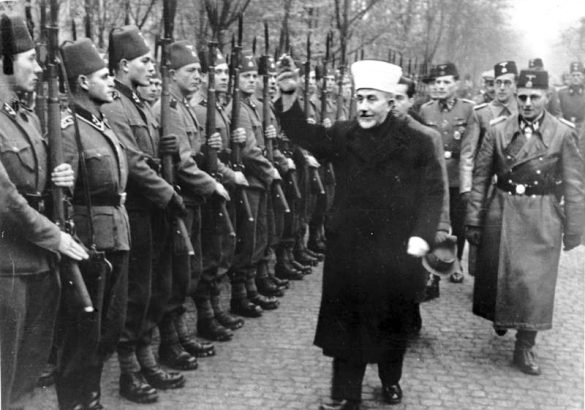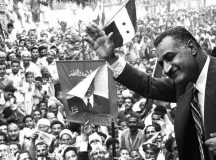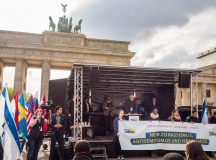Matthias Küntzel’s new book, Nazis, Islamic Antisemitism and the Middle East, explores the still under-analysed impact of Nazi antisemitism on the development of Islamic antisemitism and the Arab world’s 1948 war against the Jewish State. Here, he introduces the book’s central discoveries and arguments.
Is there any connection between the Nazi war of extermination against the Jews that ended in May 1945 and the war of the Arab armies against Israel which started in May 1948? It’s an obvious question, but one that is rarely asked. Why?
The answer is because – at least this is my assumption – the provable existence of threads of continuity between 1945 and 1948 calls into question cherished certainties: for example, the conviction that the Arab movement against Zionism and Israel had nothing to do with the Nazi fantasies of the previous phase and that Israel, i.e. Jews, were mainly responsible for the 1948 war and antisemitism in the region.
My new book Nazism, Islamic Antisemitism and the Middle East (Routledge, August 2023) challenges this conventional wisdom. It offers a new interpretation of the origins of the Arab-Israel war of 1948.
The central role of Nazi antisemitism in the planning and implementation of the Shoah is well known. The impact of that same Nazi antisemitism on the Middle East, on the other hand, remains gravely under-researched.
My book aims to fill this gap to the extent currently possible. It sets forth the methods used by Nazi Germany from 1937 onwards to disseminate its antisemitism in the Middle East in the Arabic language and the role that this antisemitism would play eleven years later, when the Arab armies fell upon the newly founded Jewish state of Israel. This fateful war triggered the Palestinian refugee catastrophe that has marked the Middle East conflict ever since.
The spread of antisemitism in the Middle East did have something to do with the Zionist movement and the building of the Jewish state. There was, however, more than one way to respond to these developments. There were, for example, Egyptians who welcomed the ‘victory of the Zionist idea [as] the turning point for … the revival of the Orient’. Others, such as the ruler of Transjordan, Emir Abdullah, sought sometimes more, sometimes less cooperation with the Zionists. A third group may have opposed Zionism, but not Judaism, while initially it was only the supporters of the Mufti of Jerusalem, Amin El-Husseini, who adopted the antisemitic approach. The Nazis exclusively backed this last group. They saw the clashes in Palestine as an opportunity to promote their form of Jew-hatred and to impose an antisemitic interpretation on the local conflict.
Only in recent years has the significance of the Nazis’ Arabic-language propaganda in the Arab world been brought to light, notably through the pioneering work of Jeffrey Herf. In 2009 he introduced us to the content of the manuscripts of the Nazis’ Arabic-language broadcasts in his book Nazi Propaganda for the Arab World. Five years later, David Motadel published further important findings in his study Islam And Nazi Germany’s War. Building on these studies, the current book presents a series of new facts that have the potential to change our view of the past and present of the Middle East conflict.
1937: Judaism and Islam
Firstly, I set out what is currently known about the origin and dissemination of the pamphlet Islam and Judaism, which was first published in 1937 in Cairo in order to derail plans for a two-state solution for Palestine. It is a shocking text that uses religion for the sole purpose of inciting Jew-hatred.
Islam and Judaism is significant because it is, as far as we know, the very first document to construct a continuity between Mohammed’s confrontation with the Jews in Medina and the contemporary conflict in Palestine, thus linking the seventh to the twentieth century. It is the first written evidence for what I call Islamic antisemitism and the forerunner of Sayyid Qutb’s 1950 pamphlet ‘Our struggle with the Jews’.
Islam and Judaism concludes with the following words:
[T]he verses from the Qur’an and hadith prove to you that the Jews have been the bitterest enemies of Islam and continue to try to destroy it. Do not believe them, they only know hypocrisy and cunning. Hold together, fight for the Islamic thought, fight for your religion and your existence! Do not rest until your land is free of the Jews.” “Free of the Jews” – “Judenfrei” – is a typical Nazi expression which we do not find in early Islamic writing.
The first Arabic version of Islam and Judaism was published in August 1937 in Cairo by the Director of the Palestinian-Arab Bureau of Information in Egypt, who is believed to have had many contacts with Nazi agents. In 1938 a German version of Islam and Judaism was published in Berlin under the title: ‘Islam – Judaism. Call of the Grand Mufti to the Islamic world in 1937’. Finally, during the Second World War, this brochure was printed and distributed in large numbers by German forces and translated into several languages . A translation of this document appears as an appendix to my book.
The very date of the pamphlet’s publication and dissemination – eleven years before the foundation of Israel and thirty years before Israel’s assumption of control in Gaza and the West Bank – is important. It contradicts the widespread assumption that Islamic antisemitism developed as a response to alleged Israeli misdeeds. It was not the behaviour of the Zionists that prompted the publication of this hostile text but rather the very first attempt to implement a two-state solution for Palestine. This fact suggests that Jew-hatred was a cause, not a consequence of the crises in the Middle East conflict.
1938/39: Goebbels and the Muslim Brotherhood
Secondly, I present new archival discoveries relating to the collaboration between German Nazi agents and the Muslim Brotherhood in Egypt. Documents from the British National Archive reveal that this collaboration was known about at the highest levels in Germany and that, according to one note, ‘GOEB. [Goebbels] has spoken about it with much praise.’ Nazi agents not only transferred money to the Muslim Brotherhood, but also attended conferences of this organisation, held common ‘Palestine meetings’ with it and gave lectures to its members on ‘the Jewish question’. After 1945, this Nazi operation paid off when that very same Muslim Brotherhood, now grown into an influential mass movement, pushed the Arab rulers into war against Israel.
1939-1945: Arabic-language radio propaganda
Thirdly, I analyse the six years of antisemitic radio propaganda in Arabic that the Nazis broadcast from the small town of Zeesen, near Berlin, which – unlike the written text – could reach the Arab masses. Back then, listening to the radio was a public affair: the men listened to it at the bazaar, in marketplaces and in coffee houses. The content of the programmes would become the dominant topic of conversation, multiplying their impact.
This is what the British secret service reported on the impact of Radio Zeesen:
In general it may be said that the middle, lower middle and lower classes listen to the Arabic broadcasts from Berlin with a good deal of enjoyment. They like the racy, ‘juicy’ stuff which is put over … What the average Palestine Arab does imbibe, however, is the anti-Jew material. This he wants to hear and to believe; and he does both. To that extent German propaganda is definitely effective.
The ‘anti-Jew material’ was effective because the Nazis could build on the patterns of early Islamic anti-Judaism and instrumentalise the local conflict with the Zionists. In addition, the BBC and the other Allied broadcasters gave in to the Nazis by failing directly to challenge their anti-Jewish incitement. None of them wanted to be seen as defenders or even ‘accomplices’ of the Jews – thus confirming aspects of the Nazi propaganda.
My book shows that in retrospect, those six years of daily radio propaganda marked a turning point dividing Middle Eastern history into a ‘before’ and an ‘after’. These years worsened the image of the Jews in the Arab world. They fostered an exclusively anti-Jewish reading of the Qur’an. They popularised the European world-conspiracy myths. They shaped a genocidal rhetoric towards Zionism. A consequence of this propaganda was that by 1948 large swathes of the Arab public viewed a Jewish state as a mortal threat that had to be violently destroyed.
1944: weapons ‘for the battles to follow’
Fourthly, I describe certain measures taken by the Nazis in 1944/45 to prepare for the forthcoming war against Israel. With their own defeat looming, they wished to preserve their antisemitic legacy by taking steps to prevent the future establishment of a Jewish state. Thus, in his memoirs, Amin el-Husseini, the former Mufti of Jerusalem, relates that in October 1944 the Wehrmacht provided aircraft to store ammunition and weapons in Palestine as ‘preparations for the days after the end of World War II’ and ‘for their preparation for the battles to follow’. On 6 October 1944, five Nazi parachutists did indeed fly out from Athens to land in the Jordan valley with the task of hiding crates of weapons that they had previously dropped from the plane. Ten days later they were captured by the British. While this may have been an isolated and ineffective action, it nonetheless provides a direct link between the Nazis’ world war and the ‘battles to follow’ in Palestine.
1947/1948: Arab hesitation, Islamist mobilisation
Fifthly, my book shows that Arab attitudes toward Zionism were less monolithic than has often been assumed. Thus, already in 1937, there were many Arabs who supported the two-state solution for Palestine. Admittedly, the Arab League unanimously opposed the two-state solution for Palestine advocated by the United Nations in November 1947. Even so, how to react to this decision was disputed until the last minute: on several occasions the Arab League ruled out the possibility of an attack by regular Arab forces on the Jewish state. Egypt, for example, questioned this war, which began on May 15, 1948, only a few days before it began: ‘We shall never even contemplate entering an official war’, declared General Muhammad Haidar, Egypt’s Defence Minister, at the beginning of May 1948. ‘We are not mad’.
Why did an ‘official war’ against Israel nevertheless take place? My book provides evidence that it was primarily pressure from the ‘Arab street’ and the antisemitic campaigns of the Muslim Brotherhood that led the Arab rulers to overcome all their doubts and attack Israel. In 1948 the Muslim Brotherhood was the largest antisemitic movement in the world, with one million members. It was determined to continue the war to prevent a Jewish state started by Hitler and the Mufti. Its campaign could draw on the lingering echoes of the antisemitic Nazi propaganda in which preventing the emergence of a Jewish state and wiping out the Jews living in Palestine had been constant themes.
This war was not inevitable. It took place despite many countervailing considerations because the Nazis’ antisemitic Arabic-language propaganda had shaped the postwar political climate. In this feverish atmosphere, no Arab leader felt able to successfully resist the Brotherhood’s warmongering. There are, therefore, good grounds for interpreting the Arab war against Israel as a kind of aftershock of the previous Nazi war against the Jews. Amin el-Husseini embodied the continuity of the two events. His religiously packaged antisemitism, which had cost thousands of Jews their lives in 1944, was four years later directed against Israel.
Why the ignorance?
So why then is the role of Nazi propaganda and Nazi policies largely ignored in debates on the roots of antisemitism in the Middle East? A plausible hypothesis is that this pattern of omission reflects a desire to protect a proposition that is accepted as dogma in many academic circles: the idea that Israel, i.e. Jews, bears sole responsibility not only for the war in 1948, but also the antisemitism in the region. Claims such as ‘The spread of antisemitism in the Arab-Islamic world is the consequence of the Palestine conflict’ are widespread.
From this paradigm, numerous Middle East experts derive mitigating circumstances for Arab antisemitism. ‘Is the fantasy-based hatred of the Jews that was and still is typical of European racists … the equivalent of the hatred felt by Arabs enraged by the occupation and/or destruction of Arab lands?’, is the rhetorical question of the British-Lebanese anti-Zionist Gilbert Achcar. ‘Arab antisemitism, in contrast to European anti-Semitism, is at least based on a real problem, namely the marginalization of the Palestinians,’ insists German Islam researcher Jochen Müller.
This paradigm, which distinguishes between a Nazi-like European antisemitism and an ‘at least’ understandable hatred of Jews in the Middle East, hides the Nazi influence on the image of Jews held by many Muslims in the Middle East. And it has political consequences: the basic assumption that antisemitism in the Arab-Islamic world is merely a response to Israel and can therefore be downplayed as a kind of local custom is one of the foundations of German and European Middle East policy and may be one of the reasons why the latter refuses to decisively combat the Jew-hatred of, for example, Hezbollah and the Iranian regime.
It is, however, necessary to understand how strongly modern Middle East history is shaped by the aftermath of National Socialism. Only then will we be able to properly understand and adequately counter the antisemitism in this region and its echo among Muslims in Europe and address the political realities of the Middle East realistically and effectively.





































Regarding
‘Arab Palestine Nazism’ since at least 1933
* 1933 – March, 2 months after Hitler came to power, the Mufti [Haj Amin al-Husseini / al-Husayni] meets German consul, offers alliance against democracies, for fascism. [1]
* ‘Falastin’, April 4, 1933, expressed appreciation for Nazi leader Adolf Hitler vs Arab Palestinian leaders. [2]
* April 1933 German Consul Wolff was contacted by the Palestine correspondent of al-Ahram, J. Francis, spokesman for a group of Palestinian Arabs. [3].
* ‘Falastin’, May 1933, calls Hitler “noble”, justifies his persecution of the Jews. [4]
* El Karmel, [Karmil] May 14, 1933 : “Will an Arab Hitler appear among us to awaken, unite and lead us to lead us to fight and defend our rights?” [5]
* Al-Difa [Ad Difa’a] had long published translated excerpts from Hitler’s Mein Kampf’s book, glorified Nazis, al-Shanti, called on Arab youth (in an article from June 1, 1934) to “learn from Hitler’s actions and imitate them.” [6]
* June 1933, Jamal al-Husseini ordered 10 copies of ‘Mein Kampf’ and that old forgery “The Protocols.” [7]
* March 15, 1935, The Templars’ ‘Die Warte des Tempels’ wrote: many Arabs saw Hitler as the most important man of the 20th century and almost every Arab knew his name. Fascism and National Socialism with its anti-Jewish attitude were accepted positively by many Arabs.
* An Apr 25, 1935 (The Sentinel) report: “From time to time, anti-Jewish slogans written in Arabic and German, and embellished with the swastika, appear on vacant walls and boardings in different Palestine towns, enjoining a boycott of Jewish goods and enterprises… According to well-informed local quarters, the origin of these throwaways is in a central Nazi propaganda agent for Palestine who it is believed, works through Arab Fascists.
An attempt at Fascism was started some eigh teen months ago as “the only hope of Arab salvation in the present state of the Arab nationalist cause,” as one young leader said. The object was to introduce an ultra-nationalistic spirit among the Arab youth. But it was more closely modelled on the National-Socialist brand of Fascism than the Italian, because the German politics embodied anti-Semitism as the central motive.
The majority of the pseudo-Fascists of Palestine is thought to be drawn from.. Arab youth and their “boss” is Issa Al Bandak, editor of a Bethlehem newspaper, who is credited some two years ago with an article seeking a transfer of the British Mandate for Palestine to Germany because, as he said, this country has shown its alertness to the “Jewish [sic] menace” and could be relied upon to effect similar “justice [sic] against the Jews” in the Holy Land! But he forgot to add that according to the Nazi racial theory, Arabs are just as non-Aryan and Semitic as the Jews… Arab Fascists … local observers think that a few of their number are working secretly at anti-Jewish propaganda of a virulent kind, such as is manifested in the swastika- signed exhortations.”
* May-June 1935, Arabs in Haifa found Nazi club ‘Red Moon.’ [8]. In May: as Arab delegates returned from Haifa Arab youth conference – Swastika on train beneath it, inscription ‘Germany above all,’ In Arabic. [9].
* June 25, 1935, Al Difa’a reported that “uniformed and Nazified” Arab youth troops are being formed in Palestine.’ [10].
* 1935-6, The Mufti, with Jamal al-Husseini establish the Futuwwa – modeled on Hitler Youth. [11].
* At ‘Falastin’, January 5, 1936: “It is very easy to explain our youth’s sympathy for the fascist idea.”
* 1936-8: “Nazi flags and pictures of Hitler were prominently displayed in store windows. Booklets explaining Nazi methods of forcing Jews from the Reich were distributed freely… The shout of ‘Heil Hitler’ became a catchword which rang insolently over all Palestine.” [12].
* 1936-9, Hilda Wilson, a teacher at Birzeit throughout the revolt, noted that most of her students were pro-Nazi and approved of Hitler. [13]
* New York Times, May 23, 1937, ‘All’ of Palestine celebrated Muhammad’s birthday with flying Nazi swastika and pictures of Hitler.
* 1937, Walter Doehle, German consul in Jerusalem: “Palestinian Arabs in all social strata have great sympathies for the new Germany and its Führer…” [14]
* Awni Abd al-Hadi (Istiqlal & AHC) in Jan 1937 to Nazi magazine : ‘Arabs Like Nazis.’ [15]
* In December 1937, both prominent Arab newspapers papers’ editors, al Issa of ‘Falastin’ and al-Shanti of ‘Al Difaa’, meet Nazi Envoy, Goebbels aide, Hans Schwarz van [von] Berk. [16]
* 1937, Mufti meets Eichman’s associates [17]. (After a Zionist bribed British not to let Eichmann to enter Palestine [18]).
* ‘Falastin’, Sep 1938, reacting to Hitler’s speech, describes dictatorship as against [sic] Jewish so-called control. [19].
* 1938, some 100 Arabs, including from Palestine, represented in Nuremberg. [20].
* 1938, Arabs and Nazi officials at ‘Palestine’ ball in Berlin. [21].
* In Mohamed Ali Eltaher published (Aschoura) “Al-Shabab” [The Youth] – in the Oct. 26,1938 issue: “Allah is the guardian of the people of Palestine who have neither Hitler nor a nation for them.”
* Journalist John Gunther in 1939: “The greatest contemporary Arab hero is — Adolf Hitler.”
* Ahmad [Shukairy / Shuqayri] Shukeiri’s testimony in his (1969) book that they (all) sympathized with the Nazis referrin to (1940-1). [22].
* Jaffa Arab activist reacalls: “Most of the Arabs in Israel were in favor of Nazi Germany.” [23].
* Sakakini’s Feb. 1941 poll – 88% of Arab-Palestine favoring the Axis. [24].
* Dr. Zaid Hamzeh (was 9 yrs old in 1941): “We Arabs supported Hitler during WWII because he hated the Jews,” (recalled in an interview October 9, 2019 interview on A One TV Jordan).
* 1941-1945, Mufti among instigators (with D. Al-Miqdadi, Zuaiter, Saba’wi [25]) toward Farhoud pogrom; worked with the Nazis; venemous [26] –with Fawzi al-Qawuqji [27] & Younes Bahri– lying broadcast to the Arab world – including calls to kill Jews everywhere; Nazism in Arabic – ‘Barid al-Sharq’ (with Shakib Arslan) [28]; plotted Crematorium in Dotan [29]; led SS Muslims units [30] – his hate booklet on Islam and his interpretation on Jews – first published by El-Taher in 1937 [31] – was used to inspire them in 1934/4; his 1941 draft, demanding from the Axis to deal with Jews in Arab counties be treated “by the same method that the ‘question’ is now being settled in the Axis counties” ![32]; intervened against children from escaping to Palestine [33]; visited conectration camps (Trebbin & Monowitz) [34]; for months: urged the Nazis to bomb Tel Aviv. [35].
Per Edward Said, pro-Nazi Mufti represented the consensus of Palestine Arabs. [36].
* CIA August 1942 report: “majority of the Arabs in Palestine Palestinian Arabs are fiercely ‘anti-Jewish’… the radicals, who form a majority, see in the approach of Rommel an ideal opportunity to murder all Jews their seize their property.” [37].
* In 1942, reaction of most Arabs in Palestine upon hearing the fate of the Jews in Europe, was: ‘open joy.’ [38].
* Dec 21, 1942 letter, representatives of the Reich and the NSDAP in Palestine described the Arabs’ hope for a great Arab state: “Arabs in Palestine were waiting for Hitler to come to Palestine and expel all the Jews.” [39].
* Oct 1945, before the Nuremberg Trials, the ”Falastin” Defends Nazism as supposedly “as much a way of life as democracy and socialism.” [40].
* 1946, Jamal al-Husseini and Ahmad Shukeiri justify the Holocaust. [41].
* Mufti and concensus. Edward W. Said (1983:7): “the Arab Higher Committee; it functioned … particularly since 1946… This committee, chaired by Palestine’s national leader, Hajj Amin al-Hussaini, represented the Palestinian Arab national consensus, had the backing of the Palestinian political parties that functioned in Palestine, and recognized in some form by Arab governments as the voice of the Palestinian people, until the P.LO….”
* Oct 1946: following the hanging of Nazi war criminals, the Arabic press full of praise for the dead Nazis: Ad Difaa, Al Wahda, Falastin. [42].
* 1947/8 Massive recruiting of Nazis to train Arabs against the Jews. [43].
______
Notes
[1]. Herf, J. (2009) Nazi Propaganda for the Arab World. United States: Yale University Press, p. 16.
[2]. Kabaha, M. (2007). The Palestinian Press as Shaper of Public Opinion 1929-39: Writing Up a Storm. United Kingdom: Vallentine Mitchell, p.142.
[3]. Die Welt des Islams. (1985). Germany: D. Reimer. Vols. 25-27, pp. 143-6.
[4]. Palestine Post, May 22, 1933, (5).
[5]. Erlich, H. (2002). The Middle East Between the World Wars (Heb.). Tel Aviv: Open University, p. 81.
[6]. Ibid.
[7]. The Sentinel, 15 June 1933, (13).
[8]. The Sentinel, 11 July 1935, (34).
[8]. Palestine Post, May 13, 1935, (7).
[19]. JTA, June 25, 1935, (4).
[11]. Rosen, D. M. (2005). Armies of the Young: Child Soldiers in War and Terrorism. United Kingdom: Rutgers University Press, p. 107.
[12]. Ziff, W. (1938). ‘The Rape of Palestine. New York/Toronto: Longmans, Green and Co., pp. 417, 430.
[13] Segev, T. (2001). One Palestine… United Kingdom: Picador. p. 412.
[14]. Julius, L. (Feb 8, 2018) “Arab anti-Semitism, and the Nazis,” Jewish Journal.
[15]. The Sentinel, 25 Feb. 1937, (37).
[16]. The Sentinel, 16 December 1937, (3)
[17]. The Librarians, Malul, C. (June 11, 2017). “Adolf Eichmann’s Secret Visit to Palestine.”
[18]. Ibid; Maariv, Dec. 21, 1966; Ynet, Apr 22, 2017. (In Heb.).
[19]. Palestine Post, 16 Sep. 1938, (2).
[20]. Australian Jewish News, Sep. 23, 1938.
[21]. Hatzofeh, Aug. 3, 1938, 2. (In Heb.).
[22]. Kedourie, E. (1964). Arabic Political Memoirs and Other Studies. Cass books on the Middle East, Psychology Press, pp. 189-190.
[23]. Arbel, T. (2000). The story of Muhammad Abu Sarari (Heb.). Israel: Docostory, p. 19.
[24]. Morris, B. (2008). 1948: A History of the First Arab-Israeli War, p. 21.
[25]. Ben-Yaacob, A. (1965). Babylonian Jewry : from the End of the Gaonic Period (1038 CE) to the Present Time (Heb.). Jerusalem: Ben-Zvi Institute, pp. 248-50.
[26]. Küntzel, M. ‘Nazi propaganda in the middle east And its repercussion in the post war period,’ in ‘Comprehending Antisemitism Through the Ages: A Historical Perspective.’ (2021). De Gruyter.
[27]. Cüppers, M., Mallmann, K. (2010). Nazi Palestine: The Plans for the Extermination of the Jews in Palestine. United Kingdom: Enigma Books, p. 83.
[28]. Motadel, D. (2014). Islam and Nazi Germany’s War. United Kingdom: Harvard University Press, p. 88.
[29]. Kanaan, H. (1973). Two hundred days of dread: Palestine facing Rommel’s army (Heb.). Tel Aviv: Mul-Art, p. 240.
[30]. McKale, D. M. (2006). Hitler’s Shadow War: The Holocaust and World War II. United States: Taylor Trade Publishing, p. 353.
[31]. Küntzel, M. (2023). ‘1937, The Watershed’ in ‘Nazis, Islamic Antisemitism and the Middle East: The 1948 Arab War Against Israel and the Aftershocks of World War II.’ (n.p.): Taylor & Francis.
[32]. USArchII, T120, R63, S71, F50682 ff., B255147, qtd in Rubin, B., Schwanitz, W. G. (2014). Nazis, Islamists, and the Making of the Modern Middle East. United Kingdom: Yale University Press.; “Grand Mufti Husseini Asked Hitler to Help with Arab ‘final Solution’, ” JTA, July 23, 1991.
[33]. Gilbert, M. (2014). The Routledge Atlas of the Second World War. United Kingdom: Taylor & Francis, p. 109.
[34]. Schwanitz, W. G. (Apr 6, 2021). “Photographic Evidence Shows Palestinian Leader Amin al-Husseini at a Nazi Concentration Camp,” Tablet Magazine; Van Koningsveld, (February 10, 2021). A. “Hitler’s Palestinian Ally: Grand Mufti Amin Al-Husseini,” HonestReporting.
[35]. Cüppers, M., Mallmann, K. (2010). Nazi Palestine: The Plans for the Extermination of the Jews in Palestine. United Kingdom: Enigma Books, p. 199.
[36]. Mather, R. (Mar 16, 2015). “Hitler’s war against Jews continues in ‘Palestine'”, Jerusalem Post; Herf J.. (Oct 31, 2010). “Not in Moderation,” The New Republic.
[37]. Herf, J. (2009). ‘Nazi Propaganda for the Arab World,’ p.139.
[38]. Cohen, M. J. (2014). “The Arabs and Nazi Germany,’ in ‘Britain’s Moment in Palestine: Retrospect and Perspectives,’ 1917-1948.’ United Kingdom: Taylor & Francis.
[39]. Letter and special report, Chef der Sicherheitspolizei to Reichsführer SS, 21 Dec. 1942, BArch,. NS 19/186.
[40]. “Falastin Defends Nazism “. The Palestine Post, 31 October 1945. (3).
[41]. B’nai B’rith Messenger, July 12, 1946, p.6.
[42]. The Palestine Post, 18 October, 1946. (1).
[43]. Frantzman, S. J.. (June 18, 2017) “TERRA INCOGNITA – The Palestinian mufti’s intersectionality with the Nazis”, Jerusalem Post.